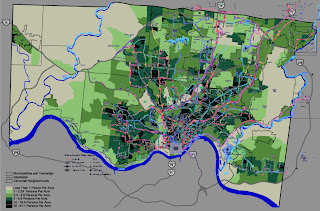More time spent in cars and less walking or biking, more time spent indoors watching television and using more energy per household. Adds up quick. So here are some easy ways to start changing your eating habits to help Cincinnati.
Eat local
The average grocery-store produce travels 1,500 miles just to get to the store. So when you get it, its carbon footprint is huge. Plus, sellers must spray produce with chemicals to keep them looking fresh longer.
The good news: buying local gets easier in Cincinnati all the time. The website Local Harvest helps you find nearby farmers' markets, as does Cincinnati Farmers' Markets (the latter has more coverage). so in addition to Findlay Market in OTR, there are lots of great nearby options. For example, my wife and I stop regularly at the Lunken Airport Farmers' Market, where we get blueberries, garlic, onions, tomatoes, summer squash, zucchini (when our garden's empty), scallions, peaches, and potatoes. And that's just the beginning. We also have a nearby Thursday Farmers' Market in Mt. Washington, a Saturday Farmers' Market in Anderson, and a Sunday market in Hyde Park. Good people, good company, good food.
Also, Cincinnati Locavore is a great resource for all things local-food related, including restaurants that source local food.
Choose fresh, not frozen
Frozen food has gotten better tasting over time, and sales have gone way up as well. Plus, thanks to better living through chemistry, much frozen food has the same nutritional content as its fresh counterparts (think of individual items here like blueberries, not Swanson's Angry Man dinners). However, creating meals, freezing them, shipping them across the country, and continuing to store them in freezers causes environmental havoc because it requires so much more energy. I know that frozen foods are time savers for parents with children (the rise in frozen food sales corresponds to the rise in the number of families where both parents work), but fresh food tastes better, sustains local farms, and makes cooking more fun. It's pretty amazing to eat a dinner of salad and herbs from your garden along with potatoes, green beans, and collard greens you bought from a farmer in Northern Kentucky.
Eat organic, and eat green
Bad news about meat: most of the commercially produced beef in the U.S. is full of fat and antibiotics. Same with poultry, though to a lesser extent. The good news: eating vegetarian, or at least cutting your meat habit way down, has never been easier. (Well, at least not in our lifetime.) Great vegetarian cookbooks abound, and more grocery stores sell organic tofu, tempeh, and beans. Cook them well, and they're great. Plus, restaurants offer more and better veggie options all the time.
And about organics: they don't contain pesticide residues, and they just taste better. The following twelve fruits and vegetables are the biggest carriers of pesticides when grown "traditionally":
- peaches, apples, sweet bell peppers, celery, nectarines, strawberries, cherries, lettuce, imported grapes, pears, spinach, potatoes
So start there. It's easier than you think.


